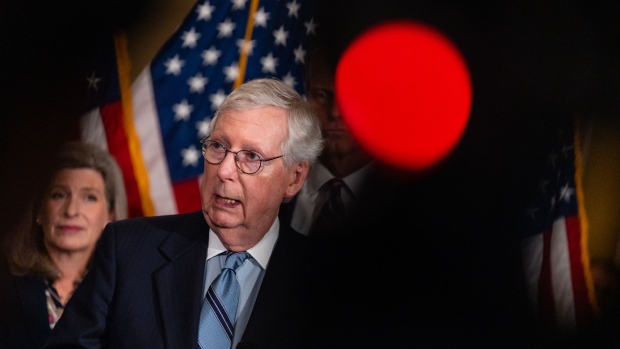Lender BlockFi Inc. filed for bankruptcy, the latest digital-asset firm to collapse in the wake of crypto exchange FTX’s rapid downfall.
BlockFi said in a statement Monday that it will use the Chapter 11 process to “focus on recovering all obligations owed to BlockFi by its counterparties, including FTX and associated corporate entities,” adding that recoveries are likely to be delayed by FTX’s own bankruptcy. Chapter 11 bankruptcy allows a company to continue operating while working out a plan to repay creditors.
The petition, filed in New Jersey, lists BlockFi’s assets and liabilities at between US$1 billion and US$10 billion each. The company said in the statement that it had around US$257 million of cash on hand, and is starting an “internal plan to considerably reduce expenses, including labor costs.”
Citing “a lack of clarity” over the status of bankrupt FTX and Alameda Research, the Jersey City, New Jersey-based company earlier halted withdrawals and said it was exploring “all options” with outside advisers.
Following investigations into FTX by the U.S. Securities Exchange Commission and Commodity Futures Trading Commission over potential misuse of customer funds, it became unclear to BlockFi where funding for a credit line from FTX U.S. and collateral on loans to Alameda, which included Robinhood Markets Inc. stock, came from, Bloomberg News reported earlier this month. BlockFi had also been in the process of shifting over its assets over to FTX for custody, but the majority of the assets had not been moved prior to FTX’s collapse.
FTX U.S. is listed in the company’s petition as one of its top unsecured creditors, with a US$275 million loan.
The company’s largest unsecured creditor, Ankura Trust Company, is owed about US$729 million, according to the petition. Ankura acts as a trustee for BlockFi’s interest-bearing crypto accounts, according to its website.
“BlockFi’s Chapter 11 restructuring underscores significant asset contagion risks associated with the crypto ecosystem, and, potentially, deficient risk management processes,” said Monsur Hussain, senior director of Financial Institutions at Fitch Ratings. He said that that these restructing processes can be “notoriously lengthy” and noted that creditors owed money by Mt. Gox are only getting closer to be paid eight years after the Bitcoin exchange failed.
BlockFi’s bankruptcy shares similarities with that of FTX, according to Eric Snyder, partner and chairman of the bankruptcy department at law firm Wilk Auslander. He said in an interview that in both filings, the names of many of the key creditors have not been disclosed, which is unusual in a bankruptcy filing. Snyder also said that it will take a while to determine the total amount of money owed to creditors in both cases.
BlockFi was founded in 2017 by Zac Prince and Flori Marquez and in its early days had backing from influential Wall Street investors like Mike Novogratz and, later on, Valar Ventures, a Peter Thiel-backed venture fund as well as Winklevoss Capital, among others. It made waves in 2019 when it began providing interest-bearing accounts with returns paid in Bitcoin and Ether, with its program attracting millions of dollars in deposits right away.
The company grew during the pandemic years and had offices in New York, New Jersey, Singapore, Poland and Argentina, according to its website. Co-founder Prince in a March 2021 interview with Bloomberg said BlockFi was using proceeds from a US$350-million funding round to expand into new markets and fund new products. Bain Capital Ventures and Tiger Global were among the investors in the that round.
Originally valued at US$3 billion in March 2021, BlockFi looked to raise money at a reduced valuation of about US$1 billion in June. The firm also faced scrutiny from financial regulators over its interest-bearing accounts and agreed to pay US$100 million in penalties to the SEC and several US states in February. The SEC is listed on the bankruptcy filing as BlockFi’s fourth-largest creditor, with US$30 million owed to the agency.
BlockFi worked with FTX U.S. after it took an US$80 million hit from the bad debt of crypto hedge fund Three Arrows Capital, which imploded after the TerraUSD stablecoin wipeout in May.
The company had significant exposure to the empire of companies founded by former FTX Chief Executive Officer Sam Bankman-Fried. The company received a US$400 million credit line from FTX U.S. in an agreement that also gave the company the option to acquire BlockFi through a bailout orchestrated by Bankman-Fried over the summer. BlockFi also had collateralized loans to Alameda Research, the trading firm co-founded by Bankman-Fried.
The company is the latest crypto firm to seek bankruptcy amid a prolonged slump in digital asset prices. Lenders Celsius Network LLC and Voyager Digital Holdings Inc. also filed for court protection this year.
BlockFi sold about US$239 million of its own cryptocurrency and warned almost 250 workers that they would lose their jobs in the run-up to its bankruptcy filing, court papers show.
The case is BlockFi Inc., 22-19361, U.S. Bankruptcy Court for the District of New Jersey (Trenton).









